Cutting Tool Engineering provides coverage of more than 210 of the products that exhibitors will showcase at IMTS 2016. They are divided into tooling and workholding products, machine tools and accessories, and metalworking products. Presented here is the preview for Machine Tools & Accessories.

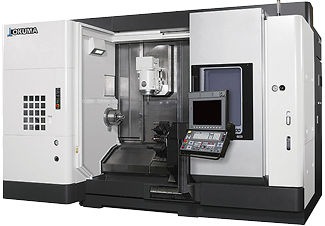
MULTITASK LATHES. The MULTUS U series of general-purpose, multitask CNC lathes from Okuma America Corp. includes two machine sizes. The MULTUS U3000 has a maximum diameter of 25.6" (650.24mm) and a bed length of 39.4" (1,000.76mm), and the MULTUS U4000 has a maximum diameter of 27.55" (699.77mm) and a bed length of 59.05" (1,499.87mm). A rigid traveling column allows cutting along the entire Y-axis. The Thermo-Friendly Concept controls thermal deformation.
Okuma America Corp.
Booth: S-8500.

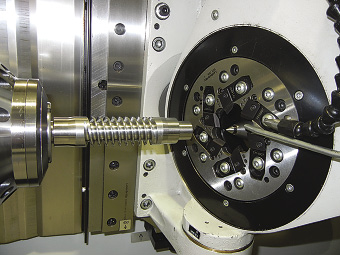
WHIRLING MACHINE. Leistritz Advanced Technologies Corp. offers the LWN-90 whirling machine for producing gear worms with short cycle times. When properly implemented into a production environment and paired with induction-hardening equipment, the whirling method eliminates thread rolling, thread milling and thread grinding while improving overall worm quality, according to the company. The machine has a 4,000-rpm, 5kW (6.8-hp) whirling spindle.
Leistritz Advanced Technologies Corp.
Booth: N-7061.

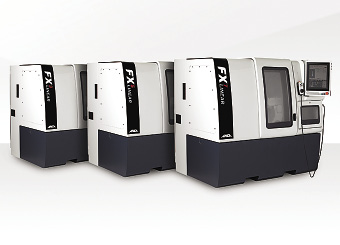
TOOL GRINDERS. In FX series CNC tool and cutter grinders from ANCA, LinX linear motors that ANCA Motion designed and built provide axis motion in the X and Y axes. The company’s FX Linear machine range covers a broad industry spectrum for light manufacturing, regrinding and production grinding. Its best performance and productivity range is for tools up to 12mm (0.472") in diameter. It offers grinding capabilities for tools up to 200mm (7.87") in diameter.
ANCA
Booth: N-7414.

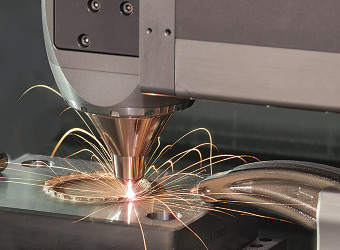
HYBRID MACHINE. Mitsui Seiki USA Inc.’s Vertex 55X-H combines additive manufacturing and subtractive machining in one machine tool platform. The vertical machining center incorporates a spindle-adapted-laser, direct-energy-deposition/powder-feed nozzle to 3D-print parts. The nozzle loads into the toolchanger like a conventional tool and is changed automatically via CNC program prompts. The hybrid machine can print new parts or add material to existing parts.
Mitsui Seiki USA Inc.
Booth: S-8519.

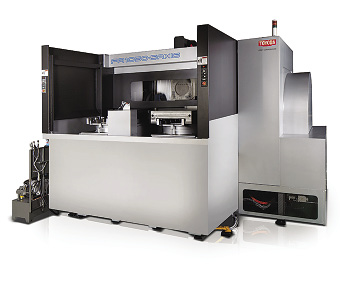
HORIZONTAL MACHINING CENTER. Toyoda Machinery USA’s FA1050 5-axis HMC is suitable for boring, endmilling, threading and U-axis machining. Spindle support from four heavy-duty bearings—double-row cylindrical roller bearings and dual angular-contact thrust bearings—eliminates vibration, claims the company. A solid cast iron base combines with a full-plate clamping mechanism that develops up to 26,000 lbs. (11,793 kg) of table clamping force. The machine has a 60-hp (44.13kW) spindle drive motor.
Toyoda Machinery USA
Booth: S-8519.

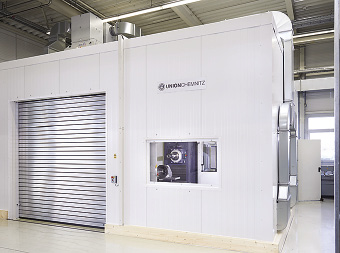
BORING MILL. UnionChemnitz says its KCG boring mill closes the gap between a classic boring mill and a jig boring machine. The enhanced positioning accuracy and geometrical precision is achieved via hand-scraped linear guide ways and optimized ribbing for increased stiffness of the machine bed and column. Measuring devices in all axes continuously monitor machining performance. A highly stable table that has a ground surface enables accurate machining of challenging workpieces, according to the company.
UnionChemnitz
Booth: S-8596.


GUNDRILLING MACHINES. Mollart Engineering Ltd.’s Omnispring 4- and 6-spindle, knee-type gundrilling machines are suitable for simultaneous high-speed drilling of oil holes in multiple automotive transmission shafts. The machines can drill a series of offset holes to varying depths in the ends of the shafts using the 3-axis movements of the machine. The machines have a FANUC 35i control and drives package.
Mollart Engineering Ltd.
Booth: S-9290.

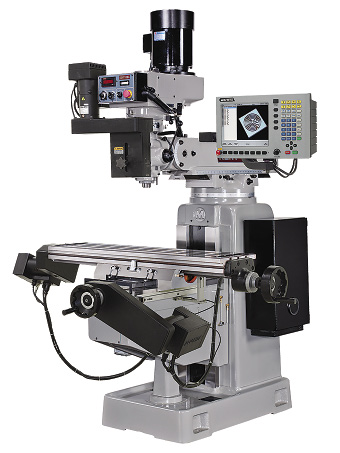
MILLING MACHINE. Kent USA Inc. equips its KTM-4VKF-E knee-type milling machine with the Acu-Rite MillPwr G2 control. According to the company, the efficiency-driven CNC allows for fast setup and short run times through conversational programming. The machine is suitable for various industries, including aerospace and automotive.
Kent USA Inc.
Booth: N-6756.

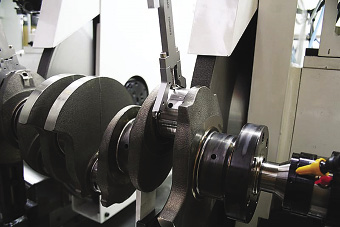
CRANKSHAFT GRINDERS. AZ spa offers the DU single-wheel-carriage and the DU2W double-wheel-carriage crankshaft orbital grinding machines. The machines have a welded base structure made of a composite material designed via finite element analysis. The headstock is made of a thermally stabilized cast iron. The tailstock is equipped with an air-suspension system that eases manual movement along the table.
AZ spa
Booth: N-7262.

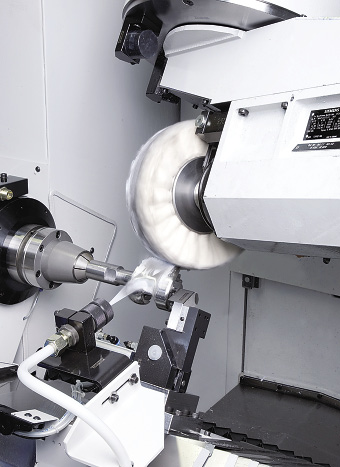
CNC GRINDER. Schütte LLC says its 325linear 5-axis CNC grinder with linear-drive technology ensures no part play and no backlash. The grinder has extended X- and Y-axis movement and two auxiliary slides for workpiece clamping. On the machine’s A-axis, a user can install collet, hydraulic-expansion or multiple-range chucks. With the automated collet changer, workpieces with different diameters can be clamped with high concentricity in the unmanned loader station. The A-axis configuration also permits position-oriented clamping of nonrotationally symmetrical workpieces.
Schütte LLC
Booth: N-7516.

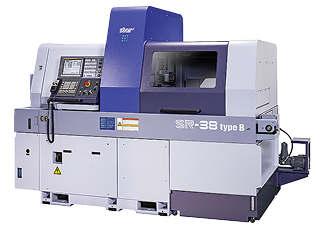
COMPLEX-PART MACHINING. Star CNC Machine Tool Corp. offers the 10-axis SR-38/B for machining complex, large-diameter parts. With the efficient Star motion control system, B-axis versatility and an 8-spindle back-working unit, the machine accommodates complex geometries in one operation, according to the company.
Star CNC Machine Tool Corp.
Booth: S-8874.

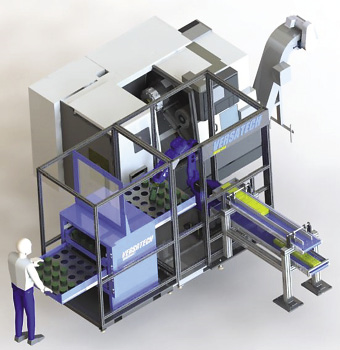
AUTOMATED CELL. Versatech LLC offers the VersaCell robotic machine-tending cell to help manufacturers mitigate the workforce skills gap. It uses robots to perform machine loading and tending functions. This reduces personnel requirements for a two-machine production center by as much as 66 percent, according to the company. An operator just loads parts onto the included conveyor or drawer system and unloads the completed parts. With the drawer system, multiple parts can be staged for machining.
Versatech LLC
Booth: N-6297.

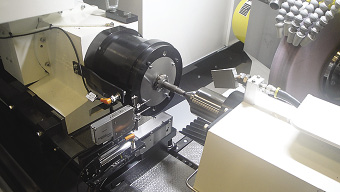
OD GRINDER. Weldon Solutions’ Midas CNC OD grinder features an optical gage system for an automated production environment. This system uses optics to measure multiple diameters and lengths on a large family of pinion gear shafts. The gage communicates directly with the grinder’s in-process sizing gage, providing signals for automatic size control. The benefit of optical gaging is that setup from part to part only requires an operator to enter a new part number.
Weldon Solutions
Booth: N-6850.

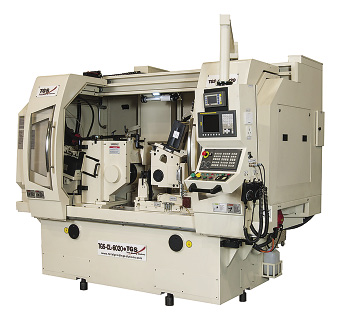
CENTERLESS GRINDER. The TGS-CL-6020 centerless grinder from Total Grinding Solutions is configured for through-feed and in-feed grinding. The regulating-wheel spindle’s outboard design maximizes spindle rigidity and supports and facilitates material rotation, according to the company. The grinder has a 2-axis CNC wheel dresser and integrated, preloaded rolling guide ways. The honeycomb machine bed also enhances rigidity.
Total Grinding Solutions
Booth: N-7467.

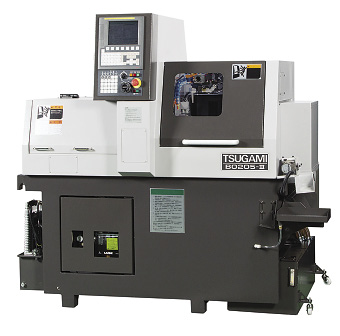
CNC LATHES. Tsugami/Rem Sales released four Tsugami opposed-gang-tool CNC lathes. The 5-axis B0125-III and 6-axis B0126-III are 12mm (0.472") machines. The B0205-III (pictured) and B0206-III are 20mm (0.787") machines with five and six axes, respectively. To increase rigidity, the electrical control cabinet was moved from inside to outside of the machine, and two additional support ribs were installed in the space that held the control cabinet. The main spindle cross-tool speeds were increased from 5,000 to 8,000 rpm.
Tsugami/Rem Sales
Booth: S-9410.

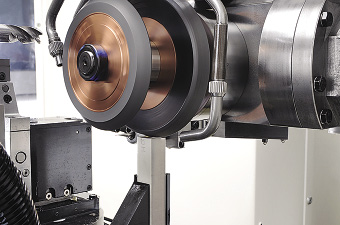
TOOL GRINDER. The GrindSmart 6-axis CNC grinder from Rollomatic Inc. is for production grinding of a variety of cutting tools. It has a six-station wheel changer with HSK 50E arbors, tested for repetitive concentricity of less than 2µm. The 20-hp (14.71kW) “synchronous" direct-drive grinding spindle offers a constant rpm without creating chatter marks in flutes, according to the company. The SmartChanger swaps out wheel packs via an automatic toolchanger without increasing cycle time.
Rollomatic Inc.
Booths: N-7200, N-7214.


BAR FEEDER. The Express 220 S2 automatic magazine bar feeder from LNS America Inc. loads 12’-long (3.7m) bars with diameters from 2mm to 20mm (0.079" to 0.787") and, with bar preparation, up to 26mm (1.024") to accommodate 20mm machines with 26mm-bar capacity. It features a high-speed headstock-synchronization system that meets the requirements of sliding-headstock machines, and a standard 240mm-wide (9.45") magazine tray. Extended-capacity tray is optional.
LNS America Inc.
Booth: S-8586.


WIRE EDM. GF Machining Solutions LLC says the AgieCharmilles CUT 2000 X wire EDM eliminates pitch and positioning errors that would otherwise result in scrapped parts and higher production costs. End users can achieve ±1.5µm pitch accuracy over a 340mm × 240mm (13.38"×9.45") work area and the same for M-shape form accuracy. Specific calibration tests ensure the machine’s performance, according to the company.
GF Machining Solutions LLC
Booth: S-8754.

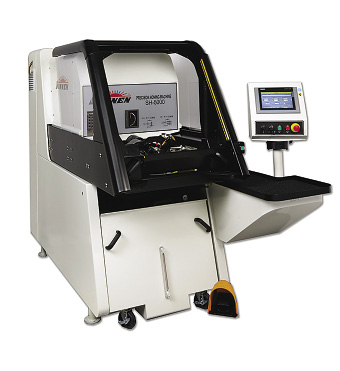
HORIZONTAL HONING MACHINE. The SH-5000 horizontal honing machine from Sunnen Products Co. is an automation-ready system for high-volume processing of small parts, such as gears, turbocharger bushings, valve components and pistol barrels. It handles parts with bore diameters from 1.5mm to 101.6mm (0.060" to 4.0"). The control enables infinite part program storage and intuitive setup, and it features a screen that allows inexperienced operators to run the machine as efficiently as veterans, according to the company.
Sunnen Products Co.
Booth: N-7400.

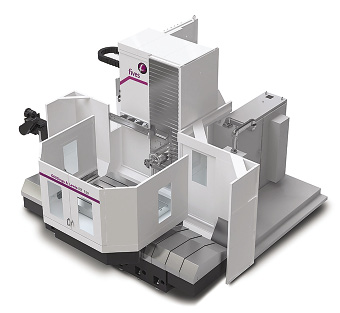
HORIZONAL BORING MILLS. Fives Giddings & Lewis says its RT 130 and RT 155 horizontal boring mills are priced and sized for job shops. The T-bed, or traveling-column, boring mills move the columns in the Z-axis direction and the tables in the X-axis direction. The machines are configured with a 1,250mm × 1,400mm (49.2"×55.1") contouring rotary table with a 10,000-kg (22,046-lb.) capacity. Low height and flat-floor installation facilitate machine relocation, if necessary.
Fives Giddings & Lewis
Booth: S-8109.

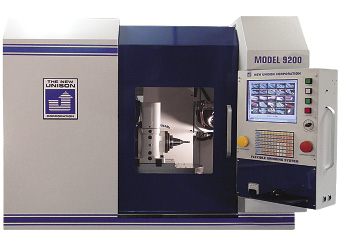
TOOL GRINDER. Unison Corp.’s Model 9200 8-axis CNC tool grinder has a 27-hp (20kW), direct-drive spindle and Yaskawa AC servodrive amplifiers. It is suitable for producing medical tools, drills, endmills, burs and reamers. An automatic pick-and-place parts loader/unloader enables continuous grinding. An onboard electric wheel dressing system is optional.
Unison Corp.
Booth: N-6648.


VERTICAL MACHINING CENTER. Enshu USA Corp.’s WE30Ve VMC has an evenly distributed, rigid bridge structure and a 12,000-rpm BT 30 spindle. The spindle drive motor offers a peak output of 17.5 hp (12.87kW) and 61 ft.-lbs. (82.7Nm) of torque. The machine’s footprint is 1,400mm × 2,520mm (55.1" × 99.2"), and it can accommodate fixtures up to 350 kg (771.6 lbs.). It comes standard with a 21-tool automatic toolchanger; a rotary pallet changer is optional.
Enshu USA Corp.
Booth: S-8592.

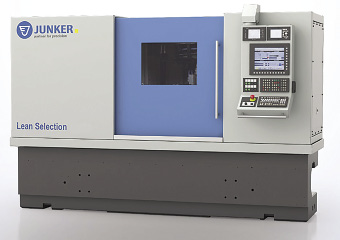
CYLINDRICAL GRINDER. Erwin Junker Machinery Inc. says the Lean Selection speed grinding machine is ideal for small and medium-size production runs in single- or multiple-shift operation. It is for grinding shaft-type parts, including cutting tool blanks. The machine can grind with CBN or diamond wheels and has a peripheral speed of up to 140 m/sec. (459.3 ft./sec.).
Erwin Junker Machinery Inc.
Booth: N-7057.

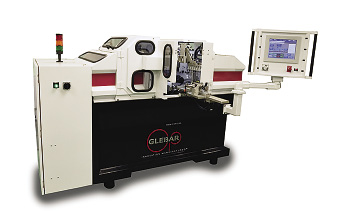
CENTERLESS GRINDING. Glebar Co. says the centerless grinding process on the GT 610 CNC grinder for automotive manufacturers expedites the development process of fuel injector nozzle valves, leading to reduced tooling costs, lower inventory levels and quicker integration of new technology for prototyping or proof-of-concept grinding of a new part. The process increases the efficiency of centerless grinding prototyping by using a single-disc CVD dress roller as part of the grinding system with the full CNC work wheel dressing.
Glebar Co.
Booth: N-7317.

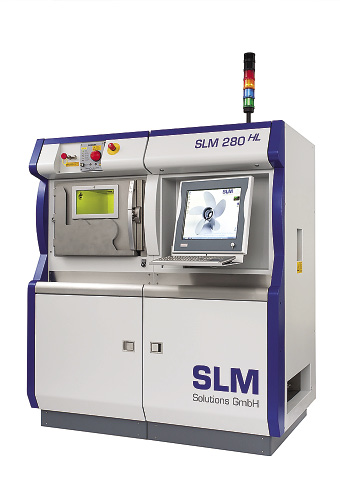
ADDITIVE MANUFACTURING. The SLM 280HL from SLM Solutions NA Inc. is a metal additive manufacturing system with a build envelope of 280mm × 280mm × 350mm (11.02"×11.02"×13.78"). It features a bidirectional recoater. By laying fresh powder on the build plate in both directions, as opposed to coating in one direction and then returning to a “home” position, build times can reportedly be reduced by 30 percent. The machine’s dual-laser configuration also reduces build times.
SLM Solutions NA Inc.
Booth: N-71.

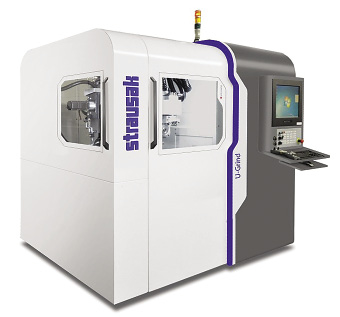
TOOL GRINDER. Strausak Inc.’s redesigned U-Grind 5-axis CNC tool and cutter grinder features NUMROTOplus tool design and grinding software. Two optional loaders are available: a small-batch loader and full robotic automation. The grinder comes standard with an automatic wheel changer and 12.5kW (17-hp) direct-drive grinding spindle. It has an automatic quick-change system for changing collets and 50-taper toolholders. A touch probe for grinding wheel qualification is optional.
Strausak Inc.
Booth: N-7214.

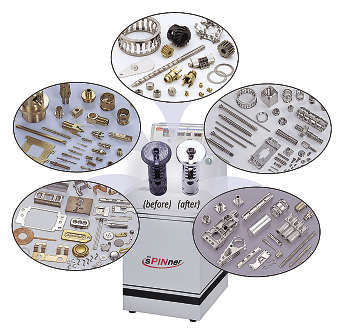
DEBURRING CENTERS. Techniks Inc. offers sPINner deburring centers for small ferrous and nonferrous parts. The pin media removes light burrs and whiskers from holes, slots, threads, cross-holes, internal cavities and other difficult-to-reach part features. Applications include medical, electronic and aerospace parts.
Techniks Inc.
Booth: W-1075.

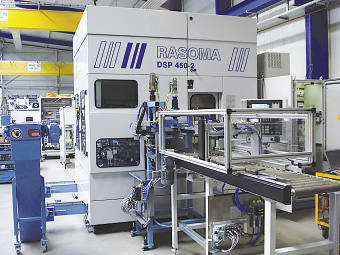
MACHINING CENTERS. Rasoma machining centers are available from German Machine Tools of America. For enhanced rigidity, the machining centers have separate X- and Z-axis slides, and the machine head is designed as a monobloc with polymer concrete fill. Thermal stability is aided by cooled motor spindles. Part-to-part time is less than 6 seconds, and turret indexing typically takes less than 1 second.
German Machine Tools of America
Booth: N-6924.

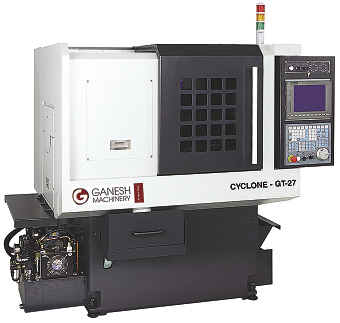
SLANT-BED LATHE. The GT-27 SL from Ganesh Machinery is a gang-tooled, slant-bed, CNC lathe with an integrated 1.125" (28.58mm) 5C collet spindle and a 7.5-hp (5.52kW), 6,000-rpm spindle. The machine has a 13.5" (342.9mm) cross-travel to hold ½" (12.7mm) turning and ¾" (19.05mm) ID toolholders. A C-axis and driven tools are available for milling, drilling and tapping. It has a Mitsubishi M70 control.
Ganesh Machinery
Booths: S-8045, S-8048.

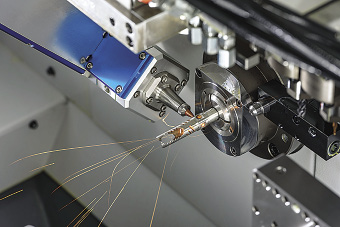
LASER SYSTEM. Marubeni Citizen-Cincom Inc.’s L2000 is a 10µm fiber-optic system for high-speed laser cutting. Incorporating the system on a Cincom Swiss-style lathe enables a user to combine conventional Swiss machining and laser cutting in a single machine. The laser system is interfaced to the machine control. The system is modular and not designed for a specific machine, enabling one system to be moved to other machines.
Marubeni Citizen-Cincom Inc.
Booth: S-9419.


TURNING CENTER. The Talent 51 MSY CNC turning center from Hardinge Inc. features the company’s quick-change, collet-ready spindle, which enhances part accuracy and surface finish. The machine comes standard with live tooling, a subspindle and a Y-axis. It has a 5,000-rpm, 25-hp (18.39kW) main spindle with 2" (50.8mm) bar capacity. The maximum turning diameter is 12.2" (309.88mm) and the maximum turning length is 24.9" (632.46mm).
Hardinge Inc.
Booth: S-8738.


GEAR GRINDER. Reishauer Corp. offers the RZ 260 gear grinding machine, which is suitable for gears with ODs up to 260mm (10.24") and modules up to 5mm (0.197"). The machine can be fitted with one or two work spindles. The version with two minimizes loading times. The grinder can be equipped with a fixed or CNC axis for swiveling the dressing tool.
Reishauer Corp.
Booth: N-7040.

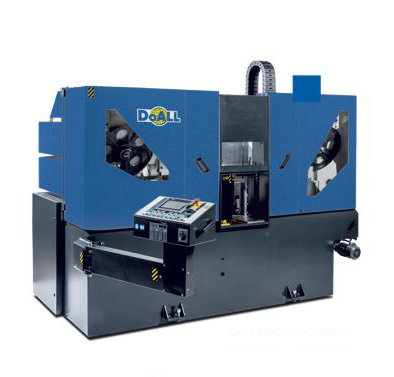
BANDSAW MACHINES. DoALL Sawing Products offers four new automatic, dual-column, enclosed Hercules CNC metalcutting bandsaws in its standard product line: the DC-300CNC, DC-400CNC (pictured), DC-510CNC and DC-750CNC. The enclosed, or “box,” bandsaws are primarily for vertical cuts and are suitable for cutting solids, tubes and profiles up to 28" (711.2mm) in diameter. Dual-column machines are ideal for a single cut or serial production cutting, according to the company.
DoALL Sawing Products
Booth: N-7074.

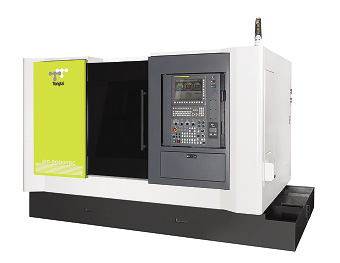
MULTITASK MACHINE. Absolute Machine Tools Inc. offers Tongai’s iTD-2000YBC multitask turning center, which has a 75° bed design for enhanced chip flow and operator accessibility. The bed also simplifies programming the optional Y-axis because the Y-axis is perpendicular to the X-axis, as is the case with a vertical machining center. The X-axis cross-travel is 9.05" (229.87mm), Z-axis longitudinal travel is 23.6" (599.44mm), B-axis subspindle travel is 24.8" (629.92mm) and Y-axis travel is ±2" (±50.8mm) from the centerline.
Absolute Machine Tools Inc.
Booth: S-8536.


FLEXIBLE MACHINING SYSTEM. The multilevel FMS from Fastems LLC offers capabilities that extend from a single manufacturing cell to a fully integrated shop-wide system. It can be controlled by the company’s MMS5 software operator interface. The interface can also be integrated with other manufacturing plant software, such as enterprise resource planning and material requirements planning. It is compatible with MTConnect.
Fastems LLC
Booth: S-9178.


BORE GRINDERS. Nagel Precision Inc. says its SPV clamp bore grinders are a cost-effective alternative to double-disc grinders, especially when bore-to-face perpendicularity is critical. An example is transmission gears. The grinder can be equipped with up to three grinding heads, and the servodriven index table can hold up to eight chucks. Multiple grinding heads permit multiple-pass operations.
Nagel Precision Inc.
Booth: N-7072.

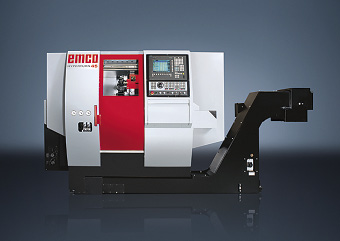
MULTITASK MACHINE. EMCO Corp.’s Hyperturn 45 mill-turn machine features main and counter spindles, two tool systems, a stable Y-axis, thermo-symmetrical machine construction, compact dimensions and intelligent automation. A 3-axis port in the machine permits automated loading and unloading. The machine can include deburring and cleaning stations.
EMCO Corp.
Booth: S-8780.

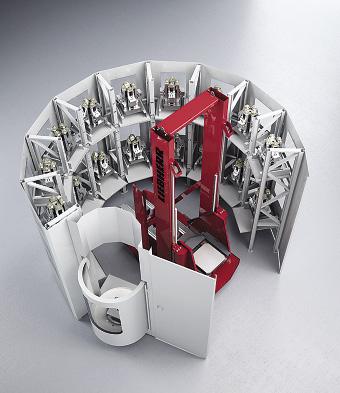
LOADING SYSTEM. Liebherr says its rotary loading system (RLS) offers high-efficiency production with one or two machining centers and promotes machine utilization of more than 90 percent. The RLS 800 is for workpieces weighing up to 800 kg (1,764 lbs.), and the RLS 1500 is for workpieces up to 1,500 kg (3,307 lbs.). Both handle workpieces with diameters up to 1,300mm (51.2").
Liebherr
Booth: N-6930.


TURN-MILL CENTER. INDEX Corp.’s G220 turn-mill center has a 5-axis, 18,000-rpm milling spindle and a tool turret with Y-axis. The fluid-cooled milling spindle has hydrostatic bearings in the Y and B axes. The distance between spindles is 1,280mm (50.39"), and the maximum turning length is 1,000mm (39.37"). The machine is suitable for bar stock up to 90mm (3.54") in diameter.
INDEX Corp.
Booth: S-8136.

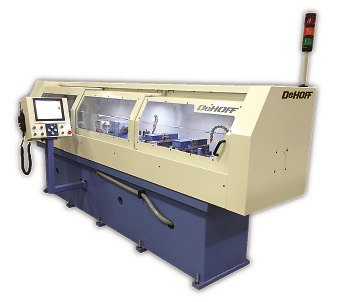
RIFLING MACHINE. The DeHoff G536-C1 from Kays Engineering Inc. is a CNC machine used to cut rifling grooves into gun barrel blanks. Because the cutting process creates a groove using a single-point cutter instead of deforming it, it does not induce any additional stresses in the barrel, according to the company. The machine is suitable for rifling 22- to 50-caliber barrels 4" to 30" (101.6mm to 762mm) long.
Kays Engineering Inc.
Booth: S-8376.

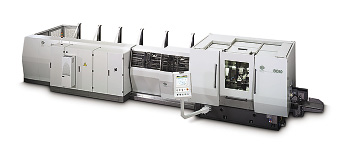
END-MACHINING CENTER. BLM Group USA says its BC80 end-machining center is ideal for cutting to length, chamfering, facing and measuring bushings up to 3.15" (80.01mm) in diameter and from 0.4" to 13.75" (10.16mm to 349.25mm) long. The bundle loader is available in lengths up to 40’ (12.19m). The machine provides in-process part measurement and 100 percent part-length inspection with statistical process control reporting.
BLM Group USA
Booth: S-8470.

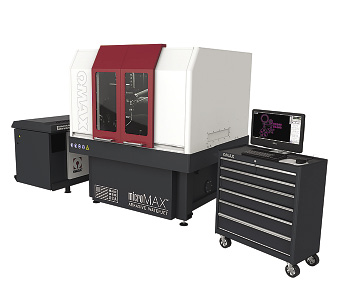
WATERJET MACHINE. OMAX Corp. offers the MicroMAX Gen 2 abrasive waterjet machine with a Tilt-A-Jet cutting head as standard equipment. The head virtually eliminates taper when cutting most materials, according to the company. The linear traction drive system uses optical encoders to provide a positioning accuracy of better than 5µm. A steel, epoxy-coated enclosure with sliding doors covers the machine.
OMAX Corp.
Booth: N-6228.

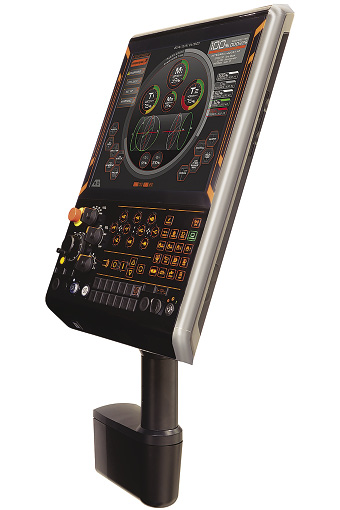
TECHNOLOGY PLATFORM. Mazak Corp. says its Smooth Technology platform incorporates advanced manufacturing cells and systems that enhance part manufacturing processes through smart machines, big data, sophisticated analytics and the Industrial Internet of Things. The Mazatrol SmoothX and Mazatrol SmoothG CNCs are part of the technology platform, which reportedly has transformed the way the company’s equipment performs, especially during 5-axis machining and complex contouring.
Mazak Corp.
Booth: S-8300.

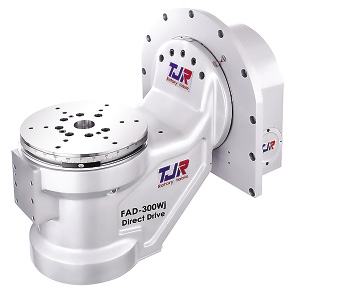
ROTARY TABLES. CNC Indexing & Feeding Technologies offers rotary tables from Tan Jia Precision Technology. The rotary tables have an antiwearing worm gear and shaft made of durable high-tensile brass. Encircling brake systems use a large clamping range to prevent displacement during heavy-duty cutting. The tilt rotary tables have a 2+1 independent braking system and large-diameter radial and axial preloaded bearings.
CNC Indexing & Feeding Technologies
Booth: S-9092.


MILLING MACHINE. The K199 6-axis milling machine is Fidia Co.’s most-compact K series machine and is reportedly ideal for producing small and medium-size molds and prototypes. The machine has a cast iron bed and worktable for high loading capacity, a rotary table for 6-axis capability, a bi-rotary milling head and a C-20 numerical control.
Fidia Co.
Booth: S-8880.

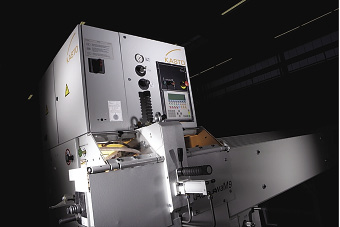
SAWING MACHINE. The Model KASTOwa C7/9 automatic circular sawing machine from Klingelhofer Corp. is for cutting steel bars with thin, throwaway, carbide-tipped saw blades. A saw-blade guidance system with carbide pads helps extend blade life and impart smooth cut surfaces. Blades from 10" to 12½" (254mm to 317.5mm) in diameter and 0.079" to 0.098" (2mm to 2.5mm) thick can be applied.
Klingelhofer Corp.
Booth: N-6670.

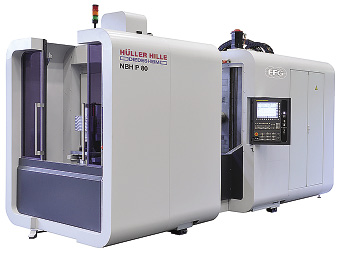
MACHINING CENTER. FFG Werke GmbH’s Hüller Hille NHB P 80 machining center has a footprint of 16.5 sq. m (54.1 sq. ft.) and offers a rapid-traverse rate of 60 m/min. (196.85 ft./min.) and an acceleration rate of 7 m/sec.2 (22.97 ft./sec.2). A choice of spindles, rotary tables and CNCs allows for flexible configuration. The chain-type magazine has 60 tool locations and can be loaded manually during machine uptime.
FFG Werke GmbH
Booth: S-8129.


CYLINDRICAL GRINDER. United Grinding North America Inc. says the radius version of the S131 internal cylindrical grinding machine combines cutting edge technologies with optimal ergonomics and ease of use. It is ideal for grinding flange parts and small workpieces common in the machine tool, drive element, aerospace and toolmaking industries.
United Grinding North America Inc.
Booth: N-6800.


FINE-GRINDING MACHINE. Supfina Machine Co.’s SPIRO F7 fine-grinding machine is suitable for finishing materials that range from soft plastics to aluminum to steel to hard ceramics. The machine can achieve a plane parallelism of less than 1.0µm. It can be customized to meet specific needs for drive performance, loading, filtration and cooling.
Supfina Machine Co.
Booths: N-6299, N-6394, N-6398.


CENTERLESS GRINDER. Koyo Machinery U.S.A. Inc. offers the C6060 centerless grinder for workpieces from 5mm to 150mm (0.197" to 5.906") in diameter. Users can apply conventional or CBN grinding wheels. A dual-supported, high-speed spindle enables long dress intervals and short cycle times. A low thermal-displacement technique improves cold-start performance, according to the company.
Koyo Machinery U.S.A. Inc.
Booth: N-7347.

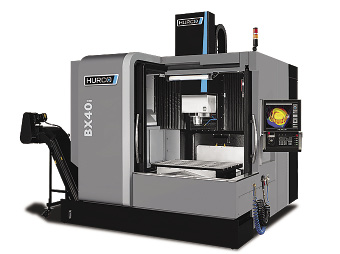
DOUBLE-COLUMN MACHINE. Hurco Cos. Inc.’s BX40i double-column, or bridge-type, CNC machine has an 18,000-rpm motorized spindle and weighs 20,062 lbs. (9,100 kg). The machine is built with size-45 roller rails on all axes, has linear scales standard and is equipped with the integrated Hurco MAX5 control, which provides multiple programming options. These include conversational, industry-standard NC and a Hurco feature called NC/conversational merge.
Hurco Cos. Inc.
Booth: S-8319.


MILLING CONTROL. The NUMmill control from NUM Corp. is suitable for a range of milling applications, including metalcutting, woodworking and plastic machining. The CNC offers an extensive suite of canned cycles, ranging from simple center drilling, boring and threading to pocket cycles and complex profile milling cycles. For all cycles, 3D simulation enables preprocess verification.
NUM Corp.
Booth: E-4837.


VERTICAL MACHINING CENTER. The QP5X-400 from Chevalier Machinery Inc. is a 40-taper VMC for 5-axis simultaneous or 4+1 applications. The standard machine is integrated with a 2-axis, 12.6" (320mm) trunnion table with a heavy-duty, three-piece, cross-roller bearing, reportedly providing excellent part loading and machining capability, and accommodates workpieces up to 220 lbs. (100kg). The X-, Y- and Z-axis travels are 20.5" (520.7mm), 15.8" (401.3mm) and 15" (381mm), respectively.
Chevalier Machinery Inc.
Booth: S-8986.

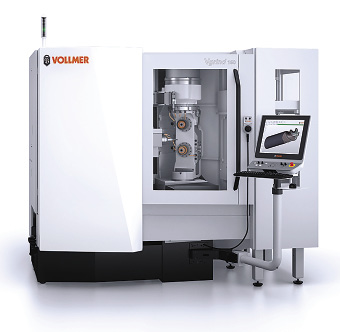
TOOL GRINDER. Vollmer of America Corp.’s Vgrind 160 CNC 5-axis grinding machine is for producing solid-carbide cutting tools up to 50mm (1.97") in diameter. According to the company, the core of the machine is the new kinematics system, which is controlled by two vertical spindles. This is because, unlike a grinder with a single spindle or horizontal double spindle, the vertical arrangement enables multilevel machining.
Vollmer of America Corp.
Booth: N-7066.

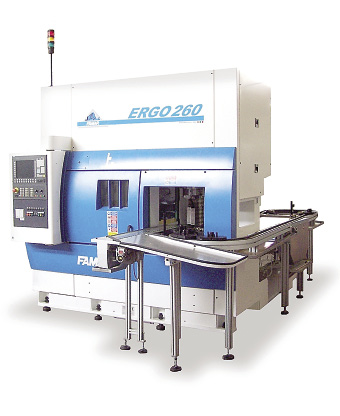
VERTICAL LATHE. Famar S.r.l says the operating system for its ERGO vertical lathe is simple but accurate. The fast and stable pickup spindle allows the lathe to load and unload itself. The machine can be customized for an end user’s production requirement by adding milling, grinding and hobbing capabilities, as well as any automation system.
Famar S.r.l
Booth: S-8966.

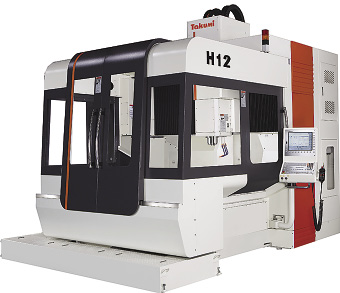
MACHINING CENTER. Takumi USA offers the H-12 bridge-type, double-column machining center. According to the company, the CNC machine enables fast throughput with an inline, direct-drive spindle. The close proximity of the spindle to the bridge casting reduces overhang and the ladder design of the bridge enhances support to the head casting. Direct-coupled ballscrews reportedly increase accuracy.
Takumi USA
Booth: S-8420.

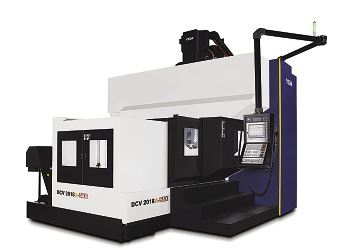
VERTICAL MACHINING CENTER. The DCV2018A-5AX from Yeong Chin Machinery Industries Co. Ltd. (YCM) is a 5-axis VMC with an 18,000-rpm, HSK A63 spindle. The reinforced double-column structure allows for smooth axial movements and low vibration to impart fine surface finishes. The universal 5-axis head has an integral motor and provides resolution accuracy of up to 0.001°.
Yeong Chin Machinery Industries Co. Ltd.
Booth: S-8450.

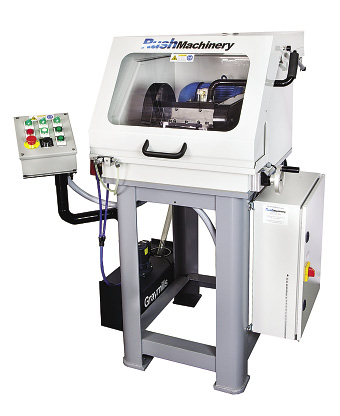
CUTOFF MACHINE. The Easy-Cut semiautomatic cutoff machine from Rush Machinery Inc. is for cutting carbide and HSS rod and tool ends. The capacity is from 1⁄8" to 1¼" (3mm to 32mm). The fully enclosed machine with flood-coolant capability features air-actuated workpiece clamping, a workpiece stop with LCD readout, a hydraulic feed cutting stroke with a neutral button for manual positioning and feeding, and automatic shutoff.
Rush Machinery Inc.
Booth: N-7233.


UNIVERSAL MACHINES. GROB Systems’ G-Series 5-axis machining centers have a retractable spindle and swivel-rotary table to enhance workpiece accessibility, even with long tools. The series includes the G350-Generation 2, which can machine a part up to 600mm (23.62") in diameter and 600mm high. By redesigning the tool magazine, the overall width of the machine has been reduced from 2,450mm (96.5") to 2,000mm (79.7").
GROB Systems
Booth: S-8574.

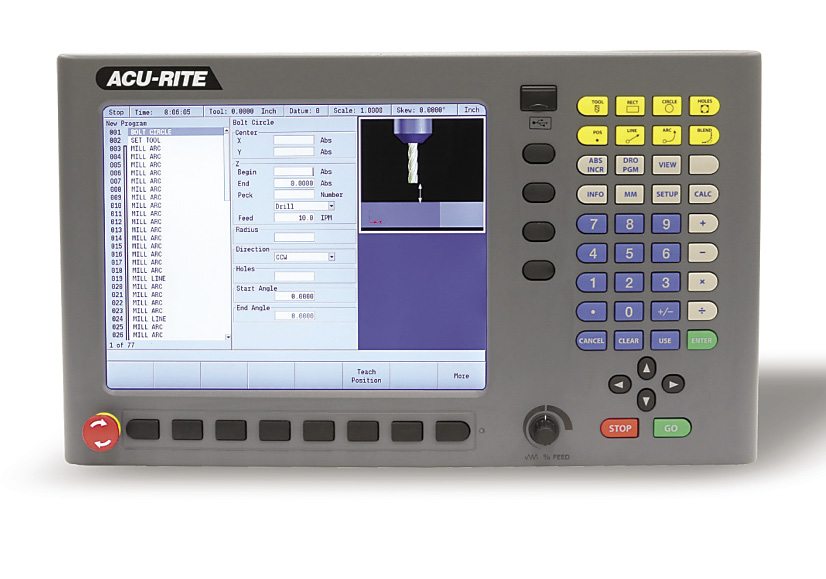
CONTROL FOR MILLS. The Acu-Rite MILLPWRG2 CNC from Heidenhain Corp. is for vertical knee and bed mills. It is available with an optional auxiliary machine interface and spindle control console, offering users the ability to use common interfaces and control the host machine tool’s spindle.
Heidenhain Corp.
Booth: E-5226.

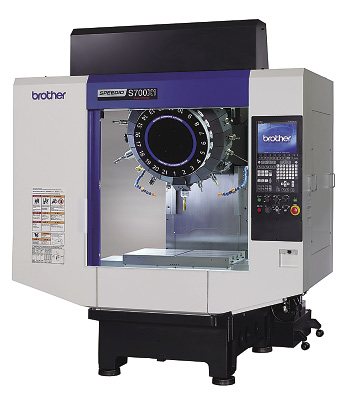
MACHINING CENTERS. Yamazen Inc. offers the compact SPEEDIO machining center line from Brother International Corp. All models feature the Brother C-00 control. The machines have high-speed spindles, up to 27,000 rpm, and high-torque spindles, up to 10,000 rpm. Nachi’s FLEX-S robotic cell is for the S300/S500/S700 models.
Yamazen Inc.
Booth: S-8640.

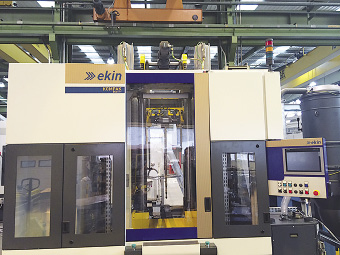
BROACHING MACHINES. In addition to hard broaching machines, such as the one shown, Broaching Machine Specialties Co. offers hard broaching tools, helical broaching machines and tools, CNC broach sharpening machines, dry broaching machines, and spline rolling machines and tools.
Broaching Machine Specialties Co.
Booth: N-7229.

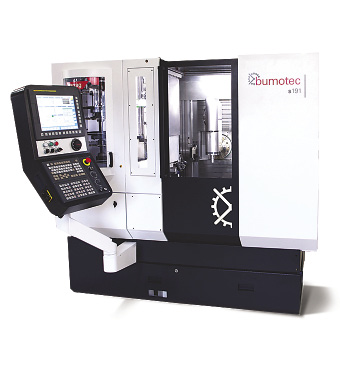
MULTITASK MACHINE. The Model s1919FTLR 7-axis turn-mill machine from Bumotec SA, part of the Starrag Group, is for manufacturing complex shapes from hard materials in a single setup. The machine combines grinding, milling, turning, gear profile generation and deburring. The advantages of machining complex parts in a single cycle include quick changeover, high productivity, reduced floor space and minimal part handling. The machine is driven by a FANCU linear motor.
Bumotec SA
Booth: S-8696.

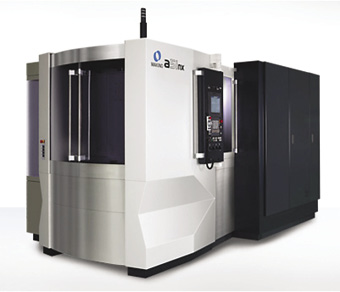
HORIZONTAL MACHINING CENTER. New versions of the a51nx (pictured) and a61nx horizontal machining centers from Makino Inc. provide expanded machining capacity through several productivity-enhancing features. These include a vision system for broken-tool detection, enhanced levels of inertia active control and Geometric Intelligence technologies. Also shown will be the a71nx 50-taper, 500mm (19.69") HMC with standard direct-drive NC rotary table.
Makino Inc.
Booth: S-8700.

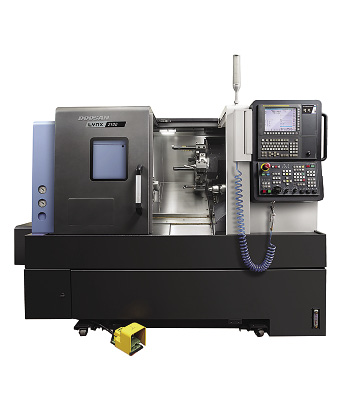
TURNING CENTER. Doosan Machine Tools America offers the Lynx 2100 series for turning parts up to 350mm (13.8") in diameter and 550mm (21.7") long. The X and Z axes are fitted with rigid, roller-type guide ways. The 15kW (20-hp) motor enables turning outer and inner surfaces and U-drilling. The machine comes with a 6,000-rpm turning spindle and 6,000-rpm subspindle, which enables back-end machining of a workpiece.
Doosan Machine Tools America
Booth: S-9100.

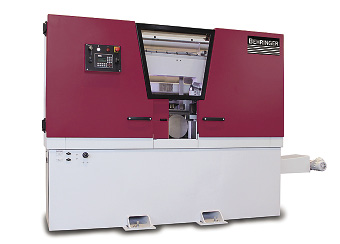
HORIZONTAL BANDSAW. The HBE Dynamic series horizontal bandsaw from Behringer Saws Inc. is suitable for application environments that range from production-cutting service centers to job shops. It has a servodriven down-feed control that automatically adjusts blade pressure, reportedly creating an optimal balance of feed rate and pressure for improved part quality, cutting rates and blade life. An electric, ballscrew-driven material feed gripper eliminates backlash and ensures precise material positioning.
Behringer Saws Inc.
Booth: N-6844.

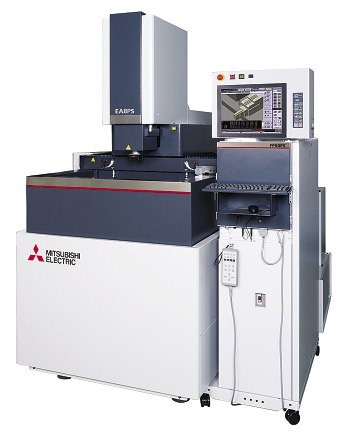
SINKER EDM. The EA8PS sinker EDM from MC Machinery Systems Inc. has a thermal-displacement compensation system and Z-axis cooling mechanism to improve accuracy by tracking and compensating for machine temperature changes. The Z-axis design uses high-quality ballscrew and linear-motion guide components. These provide excellent positioning accuracy during high-speed jump machining, according to the company.
MC Machinery Systems Inc.
Booth: N-6815.

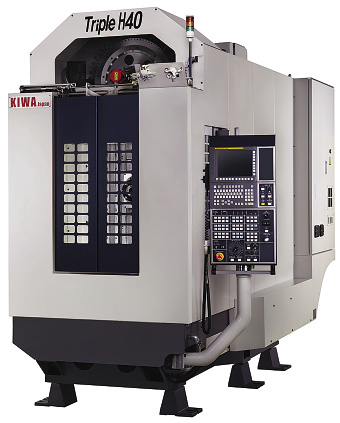
HORIZONTAL MACHINING CENTER. Methods Machine Tools Inc. offers the KIWA Triple H40 HMC with a column-traverse structure. The machine can support flexible mounting of various fixtures and rotary tables, based on the application. The stationary table design enables long workpieces to be firmly clamped to the table, eliminating the back and forth action of moving parts with special guarding and allowing access to either end of long workpieces.
Methods Machine Tools Inc.
Booth: S-9119.

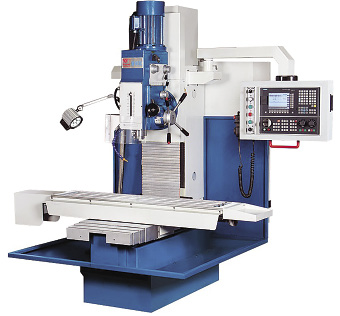
MILLING MACHINE. The KBF 900 CNC milling machine from Knuth Machine Tools USA Inc. has a heavy-duty bed and a Siemens 808 D control. According to the company, the large table, 1,102-lb. (500-kg) weight capacity and 45° swivel head make the machine versatile enough for a range of applications.
Knuth Machine Tools USA Inc.
Booth: N-6268.


HYDRAULIC PRESSES. Greenerd Press & Machine Co. Inc.’s hydraulic presses include a fully automated, 750-ton, 49’-long × 41’-wide (14.9m × 12.5m), high-speed, horizontal draw press. Presses are available in a variety of styles, from gap-frame and straight-side to die-spotting and forging presses, with production capabilities to 40,000 tons and bed sizes exceeding 20’ (6.096m).
Greenerd Press & Machine Co. Inc.
Booth: N-6412.

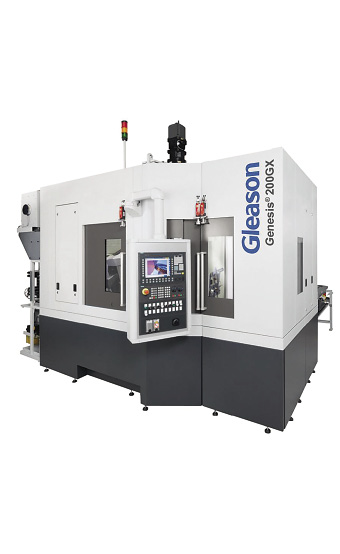
THREADED WHEEL GRINDERS. Gleason Corp. added the 200/260GX threaded-wheel grinding machines to its Genesis series. The GX machines have two spindles to minimize idle and setup times. The software-guided setup of the machine allows operators to change from one workpiece to another within 20 minutes using one tool.
Gleason Corp.
Booth: N-7000.

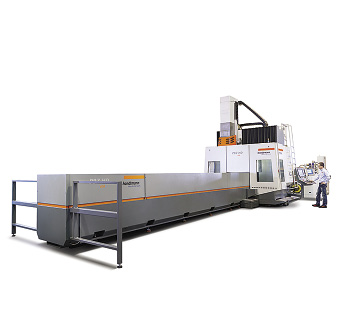
PROFILE MACHINING CENTER. Handtmann CNC Technologies Inc.’s PBZ HD 600 high-speed, 5-axis profile machining center is suitable for cutting aluminum, composite and steel profiles. The machine is 6m (19.7’) long and enables 5-sided profile machining of workpieces up to 30m (98.4’) in length.
Handtmann CNC Technologies Inc.
Booth: S-9136.

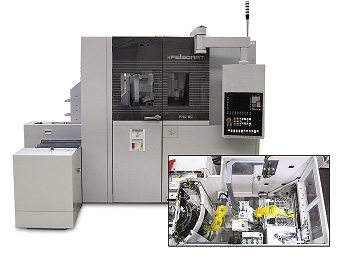
FLEXIBLE STACKING CELL. The FSC 600 machine-loading cell from Felsomat USA Inc. is built on a fabricated base for easy transportation and quick installation. The base contains any cutting fluids that may be required in the machining process and prevents those fluids from migrating to the floor. The cell has active basket hanger locks that ensure an accurate and uninterrupted loading sequence.
Felsomat USA Inc.
Booth: N-7040.

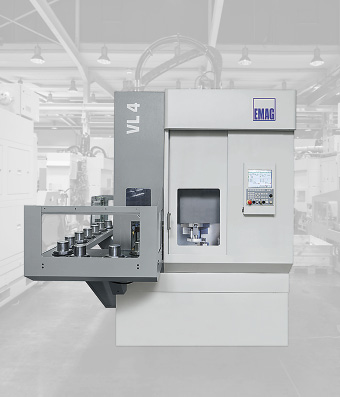
VERTICAL TURNING MACHINE. EMAG LLC says the design of its VL 4 vertical turning machine allows for diverse manufacturing capabilities and increased flexibility when soft and hard machining a range of chucked components. With the ability to easily interlink any number of machines, automation can be customized to fit an end user’s needs.
EMAG LLC
Booth: N-6834.

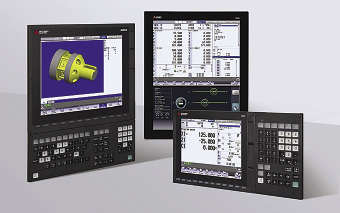
MACHINE CONTROLS. Mitsubishi Electric Automation Inc. offers the M8 series control. The company says its M800 CNC is for high-speed, high-accuracy machining and multiple-axis, multiple-part system control, while the M80 enables high productivity and is easy to operate. Both have 19" (482.6mm) touch screens with icon-based navigation for intuitive, smartphone-like operation.
Mitsubishi Electric Automation Inc.
Booth: E-4102.


GEAR GRINDING MACHINE. Star SU LLC offers the Samputensili SG 160 gear grinding machine, which grinds gears without coolant. According to the company, this evolution of the gear-generating grinding process enables cycle times of less than 2 seconds, which is shorter than traditional machines.
Star SU LLC
Booth: N-6924.


CYLINDRICAL GRINDERS. Shigiya (USA) Ltd.’s GDP CNC cylindrical grinders have a double-center drive system. The grinders are equipped with NC movable workheads on the left and right sides. The distance between centers can be adjusted without changing the setup to support workpiece lengths from 30mm to 430mm (1.181" to 16.929"). The maximum grinding diameter is 80mm (3.150").
Shigiya (USA) Ltd.
Booth: N-7463.

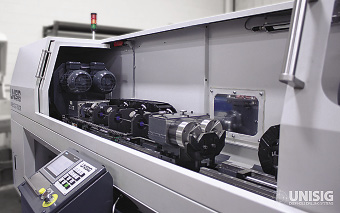
GUNDRILLING MACHINE. UNISIG says its UNE12 gundrilling machine incorporates a modular design that provides a high level of flexibility in meeting the needs of job shops seeking to maximize productivity. It can drill holes up to 0.50" (12.7mm) in diameter to a maximum depth of 30" (762mm) and is available with one to four spindles via single-spindle and dual-spindle modules.
UNISIG
Booth: S-9159.
Related Glossary Terms
- abrasive
abrasive
Substance used for grinding, honing, lapping, superfinishing and polishing. Examples include garnet, emery, corundum, silicon carbide, cubic boron nitride and diamond in various grit sizes.
- abrasive waterjet ( AWJ)
abrasive waterjet ( AWJ)
System that uses high-pressure waterjets in combination with a slurry of fine abrasive grains to machine materials. See waterjet cutting.
- automatic toolchanger
automatic toolchanger
Mechanism typically included in a machining center that, on the appropriate command, removes one cutting tool from the spindle nose and replaces it with another. The changer restores the used tool to the magazine and selects and withdraws the next desired tool from the storage magazine. The changer is controlled by a set of prerecorded/predetermined instructions associated with the part(s) to be produced.
- backlash
backlash
Reaction in dynamic motion systems where potential energy that was created while the object was in motion is released when the object stops. Release of this potential energy or inertia causes the device to quickly snap backward relative to the last direction of motion. Backlash can cause a system’s final resting position to be different from what was intended and from where the control system intended to stop the device.
- bandsaw
bandsaw
Machine that utilizes an endless band, normally with serrated teeth, for cutoff or contour sawing. See saw, sawing machine.
- boring
boring
Enlarging a hole that already has been drilled or cored. Generally, it is an operation of truing the previously drilled hole with a single-point, lathe-type tool. Boring is essentially internal turning, in that usually a single-point cutting tool forms the internal shape. Some tools are available with two cutting edges to balance cutting forces.
- boring machine
boring machine
Similar to a turning machine except that the cutting tool (single-point or multiple-cutting-edge), rather than the workpiece, rotates to perform internal cuts. However, boring can be accomplished by holding the tool stationary and turning the workpiece. Takes a variety of vertical, slanted and horizontal forms, and has one or more spindles. Typically a large, powerful machine, it can readily hold tolerances to 0.0001". See jig boring; lathe; turning machine.
- broach
broach
Tapered tool, with a series of teeth of increasing length, that is pushed or pulled into a workpiece, successively removing small amounts of metal to enlarge a hole, slot or other opening to final size.
- broaching
broaching
Operation in which a cutter progressively enlarges a slot or hole or shapes a workpiece exterior. Low teeth start the cut, intermediate teeth remove the majority of the material and high teeth finish the task. Broaching can be a one-step operation, as opposed to milling and slotting, which require repeated passes. Typically, however, broaching also involves multiple passes.
- broaching machine
broaching machine
Machine designed specifically to run broaching tools. It is typically designated by operating characteristics (pull, push, rotary, continuous, blind-spline), type of power used (hydraulic, mechanical) and tonnage ratings. Broaching is also performed on arbor presses (manual and powered).
- calibration
calibration
Checking measuring instruments and devices against a master set to ensure that, over time, they have remained dimensionally stable and nominally accurate.
- center drilling
center drilling
Drilling tapered holes for mounting workpiece between centers. Center-drilled holes also serve as starter holes for drilling larger holes in the same location. See centers; drilling.
- centerless grinding
centerless grinding
Grinding operation in which the workpiece rests on a knife-edge support, rotates through contact with a regulating or feed wheel and is ground by a grinding wheel. This method allows grinding long, thin parts without steady rests; also lessens taper problems. Opposite of cylindrical grinding. See cylindrical grinding; grinding.
- centers
centers
Cone-shaped pins that support a workpiece by one or two ends during machining. The centers fit into holes drilled in the workpiece ends. Centers that turn with the workpiece are called “live” centers; those that do not are called “dead” centers.
- ceramics
ceramics
Cutting tool materials based on aluminum oxide and silicon nitride. Ceramic tools can withstand higher cutting speeds than cemented carbide tools when machining hardened steels, cast irons and high-temperature alloys.
- chamfering
chamfering
Machining a bevel on a workpiece or tool; improves a tool’s entrance into the cut.
- chatter
chatter
Condition of vibration involving the machine, workpiece and cutting tool. Once this condition arises, it is often self-sustaining until the problem is corrected. Chatter can be identified when lines or grooves appear at regular intervals in the workpiece. These lines or grooves are caused by the teeth of the cutter as they vibrate in and out of the workpiece and their spacing depends on the frequency of vibration.
- chemical vapor deposition ( CVD)
chemical vapor deposition ( CVD)
High-temperature (1,000° C or higher), atmosphere-controlled process in which a chemical reaction is induced for the purpose of depositing a coating 2µm to 12µm thick on a tool’s surface. See coated tools; PVD, physical vapor deposition.
- collet
collet
Flexible-sided device that secures a tool or workpiece. Similar in function to a chuck, but can accommodate only a narrow size range. Typically provides greater gripping force and precision than a chuck. See chuck.
- computer numerical control ( CNC)
computer numerical control ( CNC)
Microprocessor-based controller dedicated to a machine tool that permits the creation or modification of parts. Programmed numerical control activates the machine’s servos and spindle drives and controls the various machining operations. See DNC, direct numerical control; NC, numerical control.
- conversational programming
conversational programming
Method for using plain English to produce G-code file without knowing G-code in order to program CNC machines.
- coolant
coolant
Fluid that reduces temperature buildup at the tool/workpiece interface during machining. Normally takes the form of a liquid such as soluble or chemical mixtures (semisynthetic, synthetic) but can be pressurized air or other gas. Because of water’s ability to absorb great quantities of heat, it is widely used as a coolant and vehicle for various cutting compounds, with the water-to-compound ratio varying with the machining task. See cutting fluid; semisynthetic cutting fluid; soluble-oil cutting fluid; synthetic cutting fluid.
- cubic boron nitride ( CBN)
cubic boron nitride ( CBN)
Crystal manufactured from boron nitride under high pressure and temperature. Used to cut hard-to-machine ferrous and nickel-base materials up to 70 HRC. Second hardest material after diamond. See superabrasive tools.
- cutoff
cutoff
Step that prepares a slug, blank or other workpiece for machining or other processing by separating it from the original stock. Performed on lathes, chucking machines, automatic screw machines and other turning machines. Also performed on milling machines, machining centers with slitting saws and sawing machines with cold (circular) saws, hacksaws, bandsaws or abrasive cutoff saws. See saw, sawing machine; turning.
- cylindrical grinding
cylindrical grinding
Grinding operation in which the workpiece is rotated around a fixed axis while the grinding wheel is fed into the outside surface in controlled relation to the axis of rotation. The workpiece is usually cylindrical, but it may be tapered or curvilinear in profile. See centerless grinding; grinding.
- dressing
dressing
Removal of undesirable materials from “loaded” grinding wheels using a single- or multi-point diamond or other tool. The process also exposes unused, sharp abrasive points. See loading; truing.
- electrical-discharge machining ( EDM)
electrical-discharge machining ( EDM)
Process that vaporizes conductive materials by controlled application of pulsed electrical current that flows between a workpiece and electrode (tool) in a dielectric fluid. Permits machining shapes to tight accuracies without the internal stresses conventional machining often generates. Useful in diemaking.
- endmilling
endmilling
Operation in which the cutter is mounted on the machine’s spindle rather than on an arbor. Commonly associated with facing operations on a milling machine.
- feed
feed
Rate of change of position of the tool as a whole, relative to the workpiece while cutting.
- flexible manufacturing system ( FMS)
flexible manufacturing system ( FMS)
Automated manufacturing system designed to machine a variety of similar parts. System is designed to minimize production changeover time. Computers link machine tools with the workhandling system and peripherals. Also associated with machine tools grouped in cells for efficient production. See cell manufacturing.
- flutes
flutes
Grooves and spaces in the body of a tool that permit chip removal from, and cutting-fluid application to, the point of cut.
- gang cutting ( milling)
gang cutting ( milling)
Machining with several cutters mounted on a single arbor, generally for simultaneous cutting.
- grinding
grinding
Machining operation in which material is removed from the workpiece by a powered abrasive wheel, stone, belt, paste, sheet, compound, slurry, etc. Takes various forms: surface grinding (creates flat and/or squared surfaces); cylindrical grinding (for external cylindrical and tapered shapes, fillets, undercuts, etc.); centerless grinding; chamfering; thread and form grinding; tool and cutter grinding; offhand grinding; lapping and polishing (grinding with extremely fine grits to create ultrasmooth surfaces); honing; and disc grinding.
- grinding machine
grinding machine
Powers a grinding wheel or other abrasive tool for the purpose of removing metal and finishing workpieces to close tolerances. Provides smooth, square, parallel and accurate workpiece surfaces. When ultrasmooth surfaces and finishes on the order of microns are required, lapping and honing machines (precision grinders that run abrasives with extremely fine, uniform grits) are used. In its “finishing” role, the grinder is perhaps the most widely used machine tool. Various styles are available: bench and pedestal grinders for sharpening lathe bits and drills; surface grinders for producing square, parallel, smooth and accurate parts; cylindrical and centerless grinders; center-hole grinders; form grinders; facemill and endmill grinders; gear-cutting grinders; jig grinders; abrasive belt (backstand, swing-frame, belt-roll) grinders; tool and cutter grinders for sharpening and resharpening cutting tools; carbide grinders; hand-held die grinders; and abrasive cutoff saws.
- grinding wheel
grinding wheel
Wheel formed from abrasive material mixed in a suitable matrix. Takes a variety of shapes but falls into two basic categories: one that cuts on its periphery, as in reciprocating grinding, and one that cuts on its side or face, as in tool and cutter grinding.
- gundrilling
gundrilling
Drilling process using a self-guiding tool to produce deep, precise holes. High-pressure coolant is fed to the cutting area, usually through the gundrill’s shank.
- high-speed steels ( HSS)
high-speed steels ( HSS)
Available in two major types: tungsten high-speed steels (designated by letter T having tungsten as the principal alloying element) and molybdenum high-speed steels (designated by letter M having molybdenum as the principal alloying element). The type T high-speed steels containing cobalt have higher wear resistance and greater red (hot) hardness, withstanding cutting temperature up to 1,100º F (590º C). The type T steels are used to fabricate metalcutting tools (milling cutters, drills, reamers and taps), woodworking tools, various types of punches and dies, ball and roller bearings. The type M steels are used for cutting tools and various types of dies.
- inner diameter ( ID)
inner diameter ( ID)
Dimension that defines the inside diameter of a cavity or hole. See OD, outer diameter.
- jig
jig
Tooling usually considered to be a stationary apparatus. A jig assists in the assembly or manufacture of a part or device. It holds the workpiece while guiding the cutting tool with a bushing. A jig used in subassembly or final assembly might provide assembly aids such as alignments and adjustments. See fixture.
- jig boring
jig boring
High-precision machining (a sophisticated form of milling) that originally pertained to jig and fixture manufacturing. Basic jig-boring processes include centering, drilling, reaming, through and step boring, counterboring and contouring.
- lapping compound( powder)
lapping compound( powder)
Light, abrasive material used for finishing a surface.
- lathe
lathe
Turning machine capable of sawing, milling, grinding, gear-cutting, drilling, reaming, boring, threading, facing, chamfering, grooving, knurling, spinning, parting, necking, taper-cutting, and cam- and eccentric-cutting, as well as step- and straight-turning. Comes in a variety of forms, ranging from manual to semiautomatic to fully automatic, with major types being engine lathes, turning and contouring lathes, turret lathes and numerical-control lathes. The engine lathe consists of a headstock and spindle, tailstock, bed, carriage (complete with apron) and cross slides. Features include gear- (speed) and feed-selector levers, toolpost, compound rest, lead screw and reversing lead screw, threading dial and rapid-traverse lever. Special lathe types include through-the-spindle, camshaft and crankshaft, brake drum and rotor, spinning and gun-barrel machines. Toolroom and bench lathes are used for precision work; the former for tool-and-die work and similar tasks, the latter for small workpieces (instruments, watches), normally without a power feed. Models are typically designated according to their “swing,” or the largest-diameter workpiece that can be rotated; bed length, or the distance between centers; and horsepower generated. See turning machine.
- linear motor
linear motor
Functionally the same as a rotary motor in a machine tool, a linear motor can be thought of as a standard permanent-magnet, rotary-style motor slit axially to the center and then peeled back and laid flat. The major advantage of using a linear motor to drive the axis motion is that it eliminates the inefficiency and mechanical variance caused by the ballscrew assembly system used in most CNC machines.
- machining center
machining center
CNC machine tool capable of drilling, reaming, tapping, milling and boring. Normally comes with an automatic toolchanger. See automatic toolchanger.
- metalcutting ( material cutting)
metalcutting ( material cutting)
Any machining process used to part metal or other material or give a workpiece a new configuration. Conventionally applies to machining operations in which a cutting tool mechanically removes material in the form of chips; applies to any process in which metal or material is removed to create new shapes. See metalforming.
- metalworking
metalworking
Any manufacturing process in which metal is processed or machined such that the workpiece is given a new shape. Broadly defined, the term includes processes such as design and layout, heat-treating, material handling and inspection.
- milling
milling
Machining operation in which metal or other material is removed by applying power to a rotating cutter. In vertical milling, the cutting tool is mounted vertically on the spindle. In horizontal milling, the cutting tool is mounted horizontally, either directly on the spindle or on an arbor. Horizontal milling is further broken down into conventional milling, where the cutter rotates opposite the direction of feed, or “up” into the workpiece; and climb milling, where the cutter rotates in the direction of feed, or “down” into the workpiece. Milling operations include plane or surface milling, endmilling, facemilling, angle milling, form milling and profiling.
- milling machine ( mill)
milling machine ( mill)
Runs endmills and arbor-mounted milling cutters. Features include a head with a spindle that drives the cutters; a column, knee and table that provide motion in the three Cartesian axes; and a base that supports the components and houses the cutting-fluid pump and reservoir. The work is mounted on the table and fed into the rotating cutter or endmill to accomplish the milling steps; vertical milling machines also feed endmills into the work by means of a spindle-mounted quill. Models range from small manual machines to big bed-type and duplex mills. All take one of three basic forms: vertical, horizontal or convertible horizontal/vertical. Vertical machines may be knee-type (the table is mounted on a knee that can be elevated) or bed-type (the table is securely supported and only moves horizontally). In general, horizontal machines are bigger and more powerful, while vertical machines are lighter but more versatile and easier to set up and operate.
- milling machine ( mill)2
milling machine ( mill)
Runs endmills and arbor-mounted milling cutters. Features include a head with a spindle that drives the cutters; a column, knee and table that provide motion in the three Cartesian axes; and a base that supports the components and houses the cutting-fluid pump and reservoir. The work is mounted on the table and fed into the rotating cutter or endmill to accomplish the milling steps; vertical milling machines also feed endmills into the work by means of a spindle-mounted quill. Models range from small manual machines to big bed-type and duplex mills. All take one of three basic forms: vertical, horizontal or convertible horizontal/vertical. Vertical machines may be knee-type (the table is mounted on a knee that can be elevated) or bed-type (the table is securely supported and only moves horizontally). In general, horizontal machines are bigger and more powerful, while vertical machines are lighter but more versatile and easier to set up and operate.
- modular design ( modular construction)
modular design ( modular construction)
Manufacturing of a product in subassemblies that permits fast and simple replacement of defective assemblies and tailoring of the product for different purposes. See interchangeable parts.
- numerical control ( NC)
numerical control ( NC)
Any controlled equipment that allows an operator to program its movement by entering a series of coded numbers and symbols. See CNC, computer numerical control; DNC, direct numerical control.
- numerical control ( NC)2
numerical control ( NC)
Any controlled equipment that allows an operator to program its movement by entering a series of coded numbers and symbols. See CNC, computer numerical control; DNC, direct numerical control.
- outer diameter ( OD)
outer diameter ( OD)
Dimension that defines the exterior diameter of a cylindrical or round part. See ID, inner diameter.
- pitch
pitch
1. On a saw blade, the number of teeth per inch. 2. In threading, the number of threads per inch.
- process control
process control
Method of monitoring a process. Relates to electronic hardware and instrumentation used in automated process control. See in-process gaging, inspection; SPC, statistical process control.
- sawing
sawing
Machining operation in which a powered machine, usually equipped with a blade having milled or ground teeth, is used to part material (cutoff) or give it a new shape (contour bandsawing, band machining). Four basic types of sawing operations are: hacksawing (power or manual operation in which the blade moves back and forth through the work, cutting on one of the strokes); cold or circular sawing (a rotating, circular, toothed blade parts the material much as a workshop table saw or radial-arm saw cuts wood); bandsawing (a flexible, toothed blade rides on wheels under tension and is guided through the work); and abrasive sawing (abrasive points attached to a fiber or metal backing part stock, could be considered a grinding operation).
- sawing machine ( saw)
sawing machine ( saw)
Machine designed to use a serrated-tooth blade to cut metal or other material. Comes in a wide variety of styles but takes one of four basic forms: hacksaw (a simple, rugged machine that uses a reciprocating motion to part metal or other material); cold or circular saw (powers a circular blade that cuts structural materials); bandsaw (runs an endless band; the two basic types are cutoff and contour band machines, which cut intricate contours and shapes); and abrasive cutoff saw (similar in appearance to the cold saw, but uses an abrasive disc that rotates at high speeds rather than a blade with serrated teeth).
- sawing machine ( saw)2
sawing machine ( saw)
Machine designed to use a serrated-tooth blade to cut metal or other material. Comes in a wide variety of styles but takes one of four basic forms: hacksaw (a simple, rugged machine that uses a reciprocating motion to part metal or other material); cold or circular saw (powers a circular blade that cuts structural materials); bandsaw (runs an endless band; the two basic types are cutoff and contour band machines, which cut intricate contours and shapes); and abrasive cutoff saw (similar in appearance to the cold saw, but uses an abrasive disc that rotates at high speeds rather than a blade with serrated teeth).
- statistical process control ( SPC)
statistical process control ( SPC)
Statistical techniques to measure and analyze the extent to which a process deviates from a set standard.
- stiffness
stiffness
1. Ability of a material or part to resist elastic deflection. 2. The rate of stress with respect to strain; the greater the stress required to produce a given strain, the stiffer the material is said to be. See dynamic stiffness; static stiffness.
- tapping
tapping
Machining operation in which a tap, with teeth on its periphery, cuts internal threads in a predrilled hole having a smaller diameter than the tap diameter. Threads are formed by a combined rotary and axial-relative motion between tap and workpiece. See tap.
- thread rolling
thread rolling
Chipless, cold-forming material-displacement process where a rolling head is pressed into the workpiece to create threads. The material is stressed beyond its yield point, which causes it to be deformed platically and permanently. There are three basic types of rolling heads: axial, radial and tangential.
- threading
threading
Process of both external (e.g., thread milling) and internal (e.g., tapping, thread milling) cutting, turning and rolling of threads into particular material. Standardized specifications are available to determine the desired results of the threading process. Numerous thread-series designations are written for specific applications. Threading often is performed on a lathe. Specifications such as thread height are critical in determining the strength of the threads. The material used is taken into consideration in determining the expected results of any particular application for that threaded piece. In external threading, a calculated depth is required as well as a particular angle to the cut. To perform internal threading, the exact diameter to bore the hole is critical before threading. The threads are distinguished from one another by the amount of tolerance and/or allowance that is specified. See turning.
- toolchanger
toolchanger
Carriage or drum attached to a machining center that holds tools until needed; when a tool is needed, the toolchanger inserts the tool into the machine spindle. See automatic toolchanger.
- turning
turning
Workpiece is held in a chuck, mounted on a face plate or secured between centers and rotated while a cutting tool, normally a single-point tool, is fed into it along its periphery or across its end or face. Takes the form of straight turning (cutting along the periphery of the workpiece); taper turning (creating a taper); step turning (turning different-size diameters on the same work); chamfering (beveling an edge or shoulder); facing (cutting on an end); turning threads (usually external but can be internal); roughing (high-volume metal removal); and finishing (final light cuts). Performed on lathes, turning centers, chucking machines, automatic screw machines and similar machines.
- turning machine
turning machine
Any machine that rotates a workpiece while feeding a cutting tool into it. See lathe.
- vision system
vision system
System in which information is extracted from visual sensors to allow machines to react to changes in the manufacturing process.
- wire EDM
wire EDM
Process similar to ram electrical-discharge machining except a small-diameter copper or brass wire is used as a traveling electrode. Usually used in conjunction with a CNC and only works when a part is to be cut completely through. A common analogy is wire electrical-discharge machining is like an ultraprecise, electrical, contour-sawing operation.






